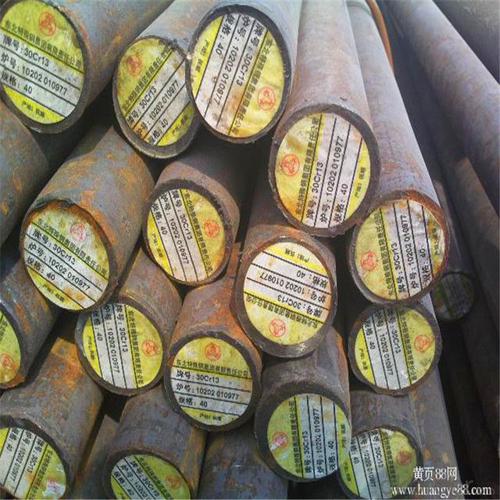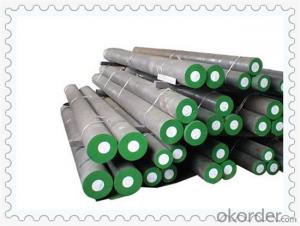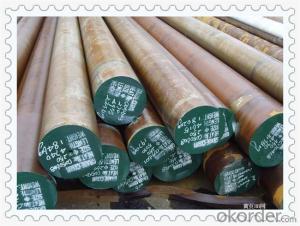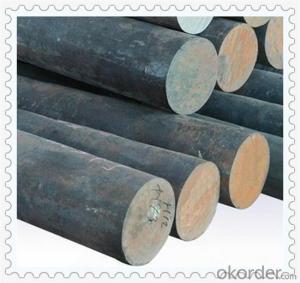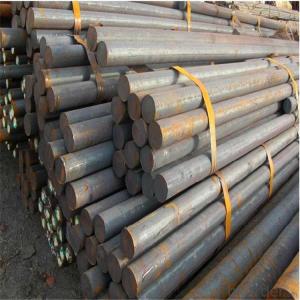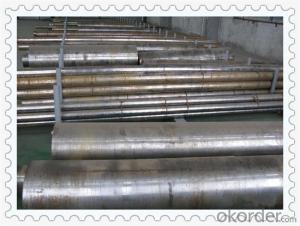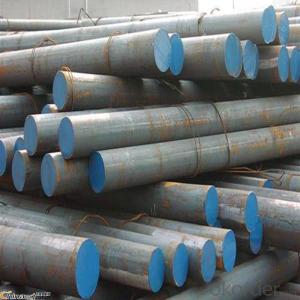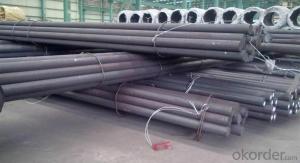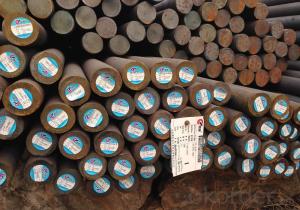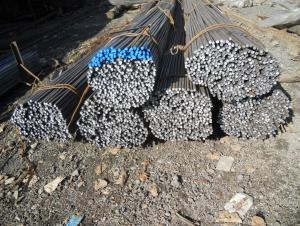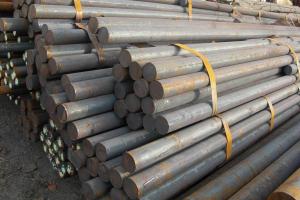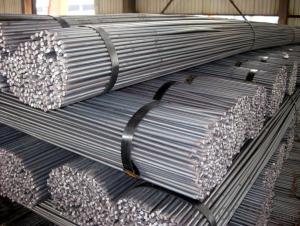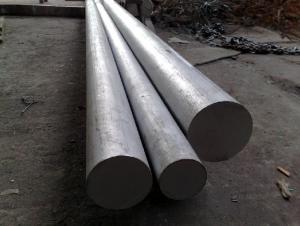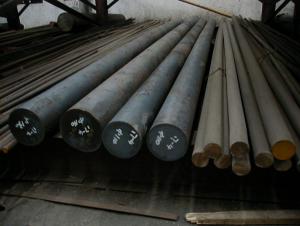AISI4140 Forged Round Bar with Turned Surface
- Loading Port:
- Tianjin
- Payment Terms:
- TT OR LC
- Min Order Qty:
- 100 m.t.
- Supply Capability:
- 50000 m.t./month
OKorder Service Pledge
OKorder Financial Service
You Might Also Like
Specification
AISI4140 Forged Round Bar with Turned Surface
Product Description of AISI4140 Forged Round Bar with Turned Surface
1. Steel grade: ASTM4140, SCM440, 42CrMo, DIN1.7225
2. Length: 6M-12M
3. Diameter: 16mm-300mm
4. Product range: round bar, flat bar, square bar
5. Technique: Hot rolled, forged, cold drawn
Specification of AISI4140 Forged Round Bar with Turned Surface
Material | AISI4140 | Round bar | Dia(mm) | 16-300mm |
Process | EAF + LF + VD + Forged + Heat Treatment (optional) | Length (mm) | Max 12m | |
Heat treatment | Normalized / Annealed / Quenched / tempered | Flat bar | Thickness(mm) | 8-500mm |
Delivery condition | Hot forged +Rough machined (black surface after Q/T)+ Turned (optional) | Width(mm) | 70-200mm | |
Test | Ultrasonic test according to SEP 1921-84 D/d | Length (mm) | Max 12m |
Chemical Composition of AISI4140 Forged Round Bar with Turned Surface
C | Si | Mn | Cr | Mo | P | S |
0.38~0.43 | 0.15~0.35 | 0.75~1.00 | 0.8~1.1 | 0.15~0.25 | ≤0.035 | <0.04< td=""> |
Photo Show of AISI4140 Forged Round Bar with Turned Surface
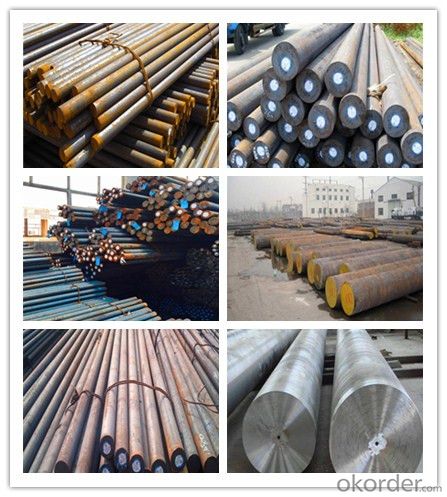
Packing and Delivery:
Packing in bundle package, or as customer's requirements.
Delivery Detail: 45 days after receiving the deposit.
Usage and Applications of AISI4140 Forged Round Bar with Turned Surface
1. Steel round bar is used in a large number of architectural and engineering structures. Or it can be used in construction of plants for the production of steel house frames, high-voltage transmission towers, bridges, vehicles, boilers, containers, ships, etc.
2. And we can use this kind of product on the performance of the mechanical parts if the demand is not very high.
3. Some special material steel round bar can be used for main shaft of steamer, hummer shank, with big section and supper force.
Company Information
CNBM International Corporation is the most important trading platform of CNBM group.
Whith its advantages, CNBM International are mainly concentrate on Cement, Glass, Iron and Steel, Ceramics industries and devotes herself for supplying high qulity series of refractories as well as technical consultancies and logistics solutions.

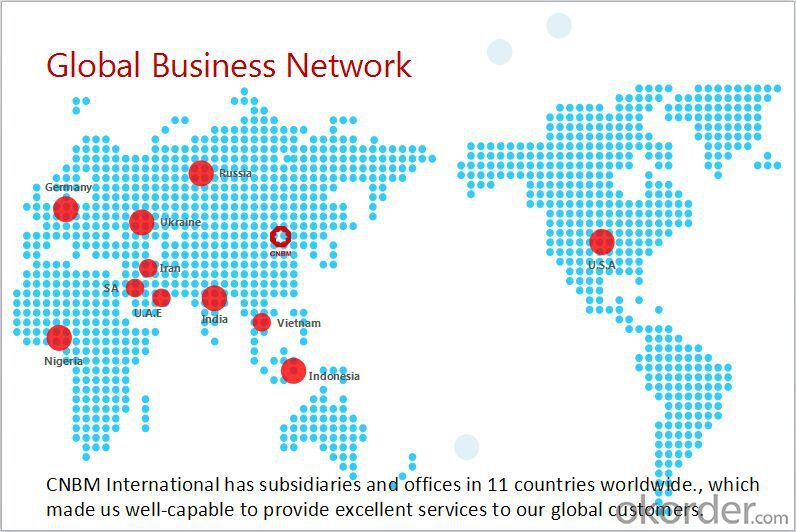
F A Q
1, Your advantages?
professional products inquiry, products knowledge train (for agents), smooth goods delivery, excellent customer solution proposale
2, Test & Certificate?
SGS test is available, customer inspection before shipping is welcome, third party inspection is no problem
3, Factory or Trading Company?
CNBM is a trading company but we have so many protocol factories and CNBM works as a trading department of these factories. Also CNBM is the holding company of many factories.
4, Payment Terms?
30% TT as deposit and 70% before delivery.
Irrevocable L/C at sight.
5, Trading Terms?
EXW, FOB, CIF, FFR, CNF
6, After-sale Service?
CNBM provides the services and support you need for every step of our cooperation. We're the business partner you can trust.
For any problem, please kindly contact us at any your convenient time.
We'll reply you in our first priority within 24 hours.
- Q: Are steel round bars available in different surface finishes?
- Yes, steel round bars are available in different surface finishes. The surface finish of a steel round bar refers to the treatment or coating applied to the surface to enhance its appearance, protect it from corrosion, or improve its performance in specific applications. Common surface finishes for steel round bars include polished, brushed, mill finish, galvanized, and coated with materials like chrome, nickel, or zinc. These different surface finishes cater to various requirements and preferences in terms of aesthetics, protection against corrosion, and functionality in different industries and applications.
- Q: What is the maximum hardness achievable for steel round bars?
- The maximum hardness attainable for steel round bars relies on various factors, including the steel's composition, the heat treatment process, and the desired properties for the specific application. Typically, steel can reach a maximum hardness of approximately 65 HRC or higher. This level of hardness is commonly achieved through procedures like quenching and tempering. Quenching entails rapidly cooling the steel from a high temperature to room temperature, resulting in a hardened structure. Subsequently, tempering is carried out to decrease brittleness and enhance the steel's toughness while maintaining a high level of hardness. It is crucial to acknowledge that pushing the hardness of steel beyond a certain point may result in reduced toughness and increased brittleness. Hence, the maximum attainable hardness must be balanced with the desired properties for the particular application, such as strength, ductility, and resistance to wear or impact.
- Q: What is the corrosion resistance of steel round bars?
- The corrosion resistance of steel round bars depends on the type of steel and the environmental conditions they are exposed to. Generally, stainless steel round bars offer excellent corrosion resistance due to the presence of chromium, which forms a protective oxide layer on the surface of the steel. This oxide layer acts as a barrier, preventing further corrosion from occurring. However, carbon steel round bars are more susceptible to corrosion, especially in environments with high moisture or exposure to corrosive substances. In these cases, additional protective measures such as coatings or galvanizing may be required to enhance their corrosion resistance. It's important to note that the performance of steel round bars in corrosive environments also depends on various factors like temperature, pH level, and the presence of other elements or chemicals. Therefore, it is recommended to consider the specific application and consult with corrosion experts to determine the most suitable steel grade and corrosion protection measures for your needs.
- Q: What is the difference between a centerless ground and a cold finished steel round bar?
- A centerless ground steel round bar and a cold finished steel round bar are both types of steel bars that have undergone different manufacturing processes, resulting in distinct characteristics and properties. A centerless ground steel round bar is produced by feeding a hot rolled or cold drawn steel bar through a grinding machine. This process removes any surface imperfections or irregularities, resulting in a smooth and uniform surface finish. The centerless grinding process also ensures tight dimensional tolerances, making the bar suitable for applications that require precise measurements. Additionally, centerless ground bars have improved straightness and roundness, which enhances their overall quality and suitability for various machining operations. On the other hand, a cold finished steel round bar is produced by cold drawing or cold rolling a hot rolled steel bar. This process involves reducing the diameter of the bar while maintaining its length, resulting in a more precise and consistent size. Cold finishing also improves the surface finish of the bar, making it smoother and more uniform. Cold finished bars have tighter dimensional tolerances and improved mechanical properties, including higher strength and hardness compared to hot rolled bars. In summary, the main difference between a centerless ground and a cold finished steel round bar lies in the manufacturing processes used and their resulting characteristics. Centerless ground bars have a smooth surface finish, tight dimensional tolerances, improved straightness, and roundness, making them suitable for precise machining applications. Cold finished bars, on the other hand, have a more precise size, improved surface finish, tighter dimensional tolerances, and enhanced mechanical properties, making them suitable for various applications requiring higher strength and hardness.
- Q: Can steel round bars be used for shafts or axles?
- Yes, steel round bars can be used for shafts or axles. Steel round bars are commonly used for these applications due to their high strength, durability, and ability to withstand heavy loads and torsional forces. They can be machined and shaped to fit specific requirements, making them suitable for various industrial and mechanical applications.
- Q: What is the difference between hot-rolled and cold-rolled steel round bars?
- The manufacturing process is the primary factor that distinguishes hot-rolled and cold-rolled steel round bars, giving rise to distinct physical and mechanical properties. Hot-rolled steel round bars are formed by subjecting a billet or ingot to extremely high temperatures, usually above 1700°F (926°C). This allows the steel to become malleable and easily shaped. The process involves passing the heated steel through large rollers, which gradually decrease the diameter and increase the length. Consequently, hot-rolled bars have a rough, scaled surface with rounded edges. The rapid cooling that follows also creates an oxide layer or mill scale on the surface. In contrast, cold-rolled steel round bars are produced by rolling the steel at room temperature or slightly below. This method offers greater control over the dimensions and surface finish of the bars. The process entails passing the steel through smaller rollers, which exert high pressure to shape and compress the material. As a result, cold-rolled bars have a smoother and more precise surface finish, with sharper edges compared to their hot-rolled counterparts. Furthermore, since the steel is not subjected to high temperatures, it retains its strength and hardness properties. The differing manufacturing processes lead to variations in the mechanical properties of hot-rolled and cold-rolled steel round bars. Hot-rolled bars typically have a higher yield strength and are generally more ductile, making them suitable for applications that involve extensive shaping or bending. On the other hand, cold-rolled bars have a higher tensile strength and are generally harder, making them suitable for applications that require greater strength and dimensional accuracy. In conclusion, the key distinctions between hot-rolled and cold-rolled steel round bars arise from the manufacturing process, resulting in differences in surface finish, dimensional accuracy, and mechanical properties. The choice between the two depends on the specific requirements of the intended application.
- Q: What is the difference between a hot rolled and a precision ground steel round bar?
- The manufacturing processes and resulting surface finishes of a hot rolled steel round bar and a precision ground steel round bar are the primary factors that differentiate them. Hot rolled steel round bars are created by heating the steel billet or ingot to high temperatures and passing it through a series of rollers to achieve the desired shape and size. This method yields a rougher surface finish with visible mill-scale or oxide layers. Additionally, the hot rolling process allows for variations in size and shape, making it a cost-effective choice for producing steel round bars in large quantities. On the other hand, precision ground steel round bars undergo a more refined and controlled manufacturing process. After the initial hot rolling, the bar is ground to achieve a smooth and consistent surface finish. Precision grinding eliminates the mill-scale and oxide layers, resulting in a more polished appearance. This process also ensures tight dimensional tolerance and improved straightness of the round bar. The selection between a hot rolled and a precision ground steel round bar depends on the specific application requirements. Hot rolled round bars are commonly used in applications where surface finish is not crucial, such as structural components, machinery parts, or construction materials. In contrast, precision ground steel round bars are employed in applications that demand a smooth surface finish, precise dimensions, and tight tolerances, such as in the production of precision tools, machinery components, or in industries like aerospace or automotive. In conclusion, the key distinction between a hot rolled and a precision ground steel round bar lies in their manufacturing processes and resulting surface finishes. Hot rolled round bars offer cost-effectiveness and versatility, while precision ground round bars provide a smoother surface finish, tighter tolerances, and improved dimensional accuracy for more demanding applications.
- Q: Can steel round bars be used for making oil and gas industry components?
- Steel round bars are a suitable choice for the production of oil and gas industry components. This is because they possess qualities like high strength, durability, and resistance to corrosion, which are highly valued in this sector. The demanding conditions of the industry, including harsh environments, high pressures, and extreme temperatures, necessitate materials that can endure such challenges. Steel round bars satisfy these requirements and are frequently employed to manufacture essential components like valves, flanges, pipes, and fittings. These components play a crucial role in the smooth functioning of the oil and gas industry. Moreover, the versatility of steel round bars allows for easy machining and welding, enabling the creation of intricate shapes and structures that are integral to this industry. In summary, steel round bars are a dependable and extensively utilized material in the production of oil and gas industry components.
- Q: What are the advantages of using creep-resistant steel round bars?
- Using creep-resistant steel round bars in various applications has several advantages. Firstly, these bars offer exceptional resistance to high temperatures and prolonged stress exposure, making them ideal for high temperature environments such as power plants, boilers, and engines. Their ability to maintain their mechanical properties at elevated temperatures is a key advantage. Secondly, these round bars possess superior creep strength, allowing them to endure constant stress over extended periods without deformation or failure. This is particularly crucial in applications where components are subjected to continuous stress, such as pressure vessels or structural machinery. The high creep strength ensures the longevity and reliability of these components. Additionally, creep-resistant steel round bars exhibit excellent corrosion resistance. They are often alloyed with elements like chromium, molybdenum, or nickel, enhancing their ability to resist corrosion in harsh environments. This makes them suitable for industries like oil and gas, chemical processing, and marine applications where corrosion is a significant concern. Furthermore, these round bars possess favorable weldability, facilitating easy fabrication and assembly. They can be welded to other components without compromising their mechanical properties, making them versatile and cost-effective for construction projects. Moreover, these round bars offer dimensional stability and high hardness, guaranteeing that components maintain their shape and mechanical properties even under extreme conditions. This characteristic makes them suitable for applications requiring precision and accuracy, such as aerospace and automotive industries. In conclusion, the advantages of using creep-resistant steel round bars include their ability to withstand high temperatures, superior creep strength, corrosion resistance, weldability, dimensional stability, and high hardness. These advantages make them the preferred choice for various industries where reliability, longevity, and performance under harsh conditions are essential considerations.
- Q: How do steel round bars compare to other materials like aluminum or titanium?
- Steel round bars have numerous advantages over materials like aluminum or titanium. Firstly, steel is renowned for its exceptional strength and durability, possessing a high tensile strength that enables it to withstand heavy loads and resist deformation under stress more effectively than aluminum or titanium. This makes steel round bars an excellent option for applications necessitating robust structural support. Moreover, steel boasts a higher melting point in comparison to aluminum, rendering it more suitable for high-temperature environments. It can endure extreme heat without compromising its strength, making it the preferred choice for industries such as construction, manufacturing, and automotive. Furthermore, steel round bars offer a cost-effective solution. Generally, steel is more affordable than titanium, making it a more budget-friendly alternative for a variety of projects. Additionally, steel is readily available and easily sourced, while obtaining titanium can be more challenging and manufacturing it can be more expensive. Nevertheless, it is imperative to acknowledge that aluminum and titanium possess their own unique advantages. Aluminum, for instance, is lightweight and exhibits excellent corrosion resistance, making it the preferred material for industries like aerospace, marine, and automotive. Conversely, titanium is renowned for its exceptional strength-to-weight ratio and corrosion resistance. It is commonly utilized in applications requiring high strength and low weight, such as aircraft components and medical implants. In conclusion, steel round bars offer unparalleled strength, durability, and cost-effectiveness when compared to aluminum or titanium. However, choosing the appropriate material ultimately depends on the specific requirements of the project, as each material possesses distinct advantages and applications.
Send your message to us
AISI4140 Forged Round Bar with Turned Surface
- Loading Port:
- Tianjin
- Payment Terms:
- TT OR LC
- Min Order Qty:
- 100 m.t.
- Supply Capability:
- 50000 m.t./month
OKorder Service Pledge
OKorder Financial Service
Similar products
Hot products
Hot Searches
Related keywords






